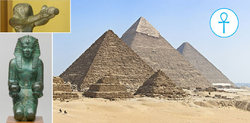- Retour accueil
- Vous êtes ici : Blog The Pyramids of the Cold The Pyramids of the Cold Section 24 • The Osiris' seed and Horus' opening of the mouth
The Pyramids of the Cold Section 24 • The Osiris' seed and Horus' opening of the mouth
Publié par Bruno Coursol dans The Pyramids of the Cold le 22/09/2022 à 04:59
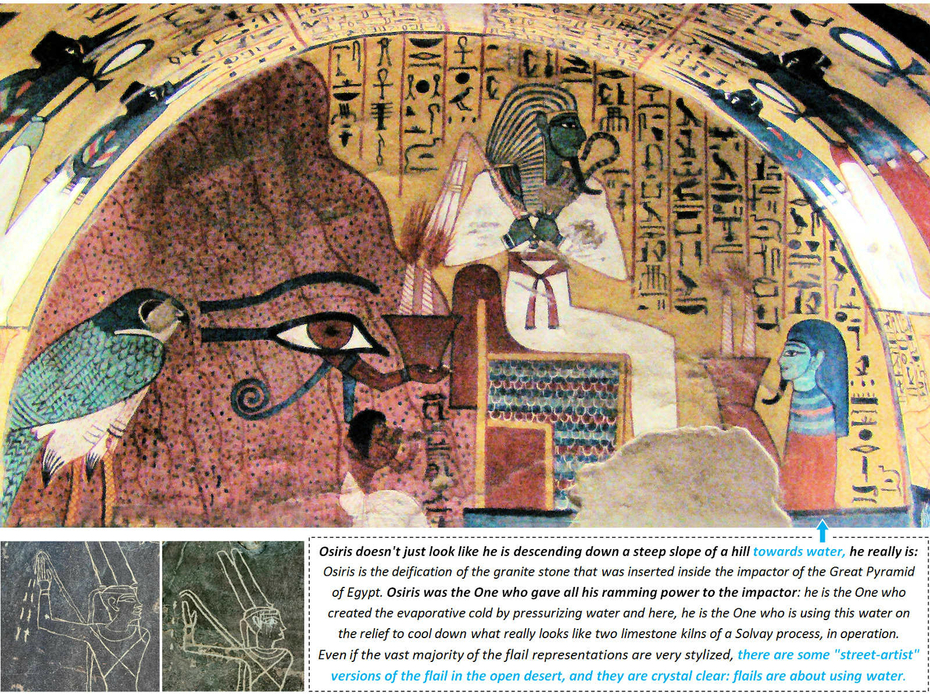
If Osiris is the ancient Egyptian god of resurrection, the after-life, fertility and agriculture, it is all explained by the fact that Osiris was the deification of the "power source" of the Great Pyramid of Egypt. Osiris was the One who gave all his ramming power to the impactor: he is the One who created the evaporative cold by pressurizing water and he is the One who is using this water on the Paschedu relief to cool down what really looks like limestone kilns in operation.
The hypothesis that the evaporative cold was created for "industrial" cooling of a Solvay process, could be valid.
On the above relief from the tomb of Paschedu, Osiris doesn't just look like he is descending down a steep slope of a hill, he really is: Osiris is the deification of the granite stone that was inserted inside the impactor of the Great Pyramid of Egypt. And if his throne looks like it is put onto water, it is because his throne and himself (the wooden cradle and the granite stone) really are going into the water.
Relief in the tomb of Paschedu, Deir el-Medina, Egypt, Luxor West-Bank, photographed by kairoinfo4u: https://www.flickr.com/photos/manna4u/430887106/in/album-72157600016963557/
Section 24 • The Osiris' seed and Horus' opening of the mouth
In summary: the one thing I'm referring to the most in this study is probably the impactor of the Great Pyramid of Egypt, and even if in Section 23, we've seen that Sun god Ra "who got all his force and all his power from Osiris", was the deification of its wooden part, the cradle which was both the vessel and the float for the Osiris stone, I was still missing how the entire impactor unit, resulting of the assembly of these two components had been deified in. In this Section, we'll see that it was the "god of the Sky" Horus who have been the glorifying representation of what I've been calling the "impactor" for months now.
The operating of the impactor inside the Grand Gallery, its endless cycle of hauling and releasing into the steep slope, had been represented and glorified into numerous myths and symbols like the Eye of Horus. The hidden meaning of the Eyes of Horus, is not in the Eyes themselves: it is in the missing parts of the face. It is about the wooden fixed caisson that is hiding both the impactor and the mouth of the inclined well; it is about Horus being the impactor itself and about the two half-Hauling beetles being the Eyes of Horus, set on both sides of the impactor.
We'll see that the Eye of Horus also had an additional meaning and that it is about the reason of why ancient Egyptians have gone to so much trouble to create evaporative cold: the overheating of the Solvay manufacturing of the mummification salt natron.
We'll see that the composite impactor of the Great Pyramid, had been deified into two different gods: Horus the child (Horus the younger) and Horus the elder. Just like the twin sisters Isis and Nephthys, Horus the elder and Horus the child are representing the impactor in two different positions into its operating cycle: Horus the elder is the impactor released into the slope of the Gallery, when Horus the child, waiting to grow is representing the impactor in its locked position at the top of the Grand Gallery, just waiting to grow speed and energy.
Finally, we'll see that the famous opening of the mouth ceremony is referring to the mechanism which released the impactor into the steep slope of the Gallery, transforming Horus the child into fastest animal on earth falcon headed god of the sky Horus.
Any discrepancy with previous Section 16, also about Horus, should be disregarded in favor of this new Section.
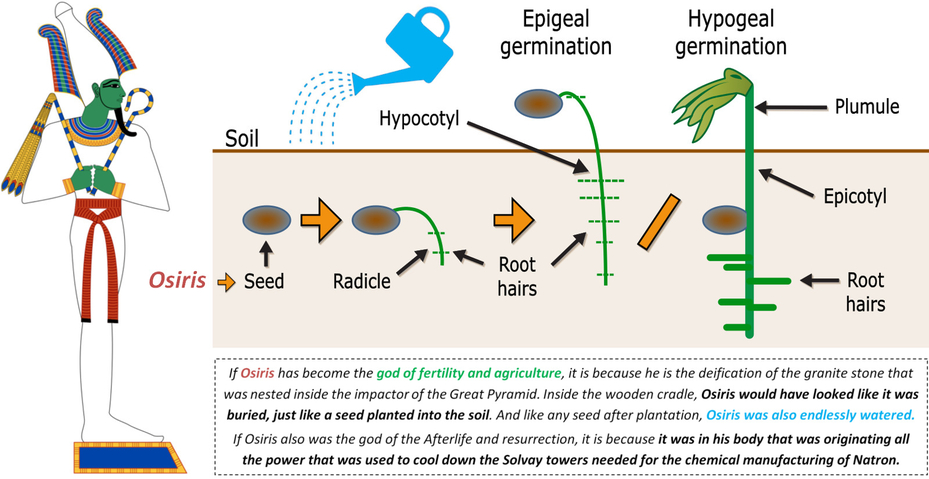
Osiris has been identified with Fertility and Agriculture, because hidden in his wooden cradle coffin, he would have looked like a seed, just waiting for germination. "Epigeal vs. hypogeal germination", by Kat1992: https://en.wikipedia.org/wiki/Epigeal_germination. Ancient Egyptian god Osiris by Jeff Dahl: https://en.wikipedia.org/wiki/Osiris#/media/File:Standing_Osiris_edit1.svg
24.01 Osiris and the seed metaphor
In previous Section 23, I've suggested that if Osiris was represented with a green color face, it was because the granite stone he was the deification of, was made of green granite. But this is most probably wrong, because Osiris doesn't just have a green color face: he is also the god of fertility and agriculture.
The green color can't be the explanation for this, but if we take a few steps back and try to imagine how ancient Egyptians could have seen Osiris, completely invisible because hidden inside the wooden coffin and constantly thrown and immersed into the waters of the inclined well, it could have been seen like a seed that would have been just planted into the soil and regularly watered.
Just like the seed contains all the force of the future plant, Osiris contains all the power of the impactor.
Hidden in the wooden cradle Ra, Osiris would have been associated with a well watered seed, just planted into the soil, preparing itself for germination, and Osiris would have become the god of fertility and agriculture.
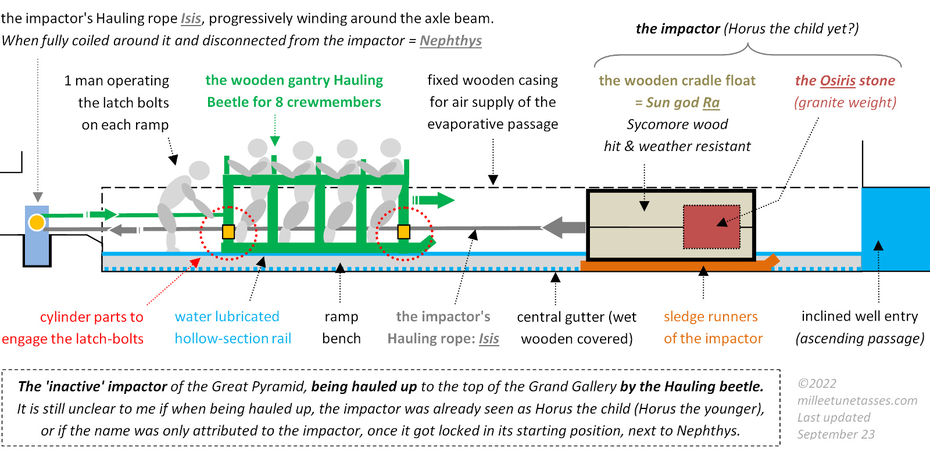
24.02 The impactor of the Great Pyramid of Egypt, being hauled up by the Hauling beetle to the top of the Grand Gallery
Side view (adapted) of the impactor of the Great Pyramid of Egypt, being hauled up by the Hauling beetle, to the top of the Grand Gallery. Of course, the impactor is not really visible like shown on the draw: the impactor is hidden inside the fixed wooden caisson.
24.03 Osiris "Banebdjedet" merging with Ra and giving him all his force and power
Not only the germinating beds of Osiris is a perfect reinterpretation of the composite original design of the impactor, but the idea itself of Osiris merging with Ra, and giving to him all his force and power is already perfectly known, in one of Osiris' aspect: Banebdjedet (also "Banebdjed").
Ra at this time becomes merged with Osiris, the judge of the dead, and Osiris is seen as the “corpse” and Ra as the “soul” of the single deity Ra-Osiris." https://www.worldhistory.org/Ra_(Egyptian_God)/
"Osiris' soul, or rather his Ba, was occasionally worshipped in its own right, almost as if it were a distinct god […] This aspect of Osiris was referred to as Banebdjedet. […] As Banebdjed, Osiris was given epithets such as Lord of the Sky and Life of the (sun god) Ra. Ba does not mean "soul" in the western sense, and has to do with power, reputation, force of character, especially in the case of a god. […] Since the ba was associated with power, and also happened to be a word for ram in Egyptian, Banebdjed was depicted as a ram, or as Ram-headed."
https://en.wikipedia.org/wiki/Osiris ("Ram god" section)
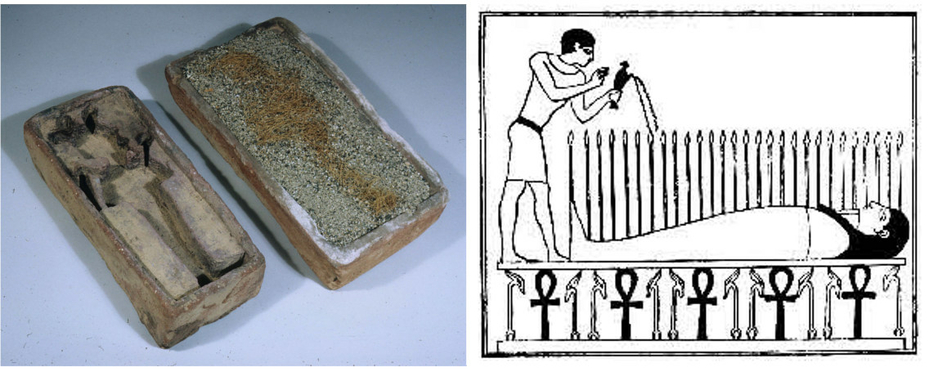
Germinating beds of Osiris at the Metropolitan Museum of Art, New-York. "Beginning in Dynasty 18, beds were made on which soil was molded into the shape of the god of regeneration and ruler of the dead, Osiris. Thickly sown with grain and kept moist until the grain sprouted and grew, then left to dry again, these figures were created as part of a ritual carried out in association with the Osirian Festival of Khoiak." https://www.metmuseum.org/art/collection/search/553820
24.04 The reproduction of the impactor's cycle in and out of the well: keeping the grain moist, then left to dry
The germinating wooden beds of Osiris, or bricks of Osiris, are particularly interesting, because not only the shape of Osiris is perfectly respected in order to duplicate the original granite stone perfectly nested into the wooden cradle, but the endless cycle of the impactor inside the inclined well, then outside the well, is also duplicated: first you keep the seeds moist until germination, and then you let the sprouted grain dry.
Osiris-Nepra (E. A Wallis Budge), with wheat growing from his body. From a bas-relief at Philae: https://en.wikipedia.org/wiki/Osiris
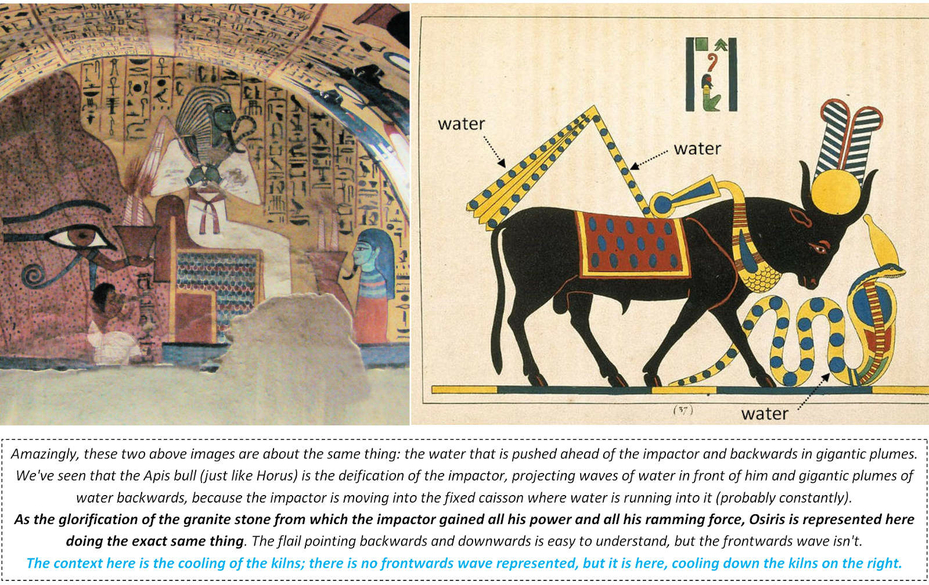
Api or Hapi (Apis, Taureau Consacré a la Lune)", 1823-25, by the French illustrator Léon-Jean-Joseph Dubois, at the Brooklyn Museum: https://www.brooklynmuseum.org/opencollection/archives/image/55326
24.05 The cooling of the limestone kilns and the flails pointing backwards and downwards
Amazingly, these two above images are about the same thing: the water that is pushed ahead of the impactor and backwards in gigantic plumes. Even if the vast majority of the flail representations are very stylized, there are some "street-artist" versions in the open desert, and they are crystal clear: flails are about using water.
We've seen that the Apis bull (just like Horus) is the deification of the impactor, projecting waves of water in front of him and gigantic plumes of water backwards, because the impactor is moving into the fixed caisson where water is running into it (probably constantly).
As the glorification of the granite stone from which the impactor gained all his power and all his ramming force, Osiris is represented here doing the exact same thing. The flail pointing backwards and downwards is easy to understand, but the frontwards wave isn't.
The context here is the cooling of the kilns; there is no frontwards wave represented, but it is here, cooling down the kilns on the right.
24.06 The fundamental difference between Horus and the Apis bull
We'll see in the next paragraphs, that Horus and the Apis bull (as well as every single over bull deity, prior to the impactor of the Great Pyramid) are the exact same thing, with just one difference: just like the difference between Isis and Nephthys (both the deification of the impactor's Hauling rope) is about a very specific part of the operating cycle of the rope (active Hauling rope/disconnected rope), Apis is simply the Horus impactor (Ra + Osiris), but in action.
Horus is more like a still-life vision of the impactor, when the Apis bull is describing him at full speed, running for the inclined well waters.
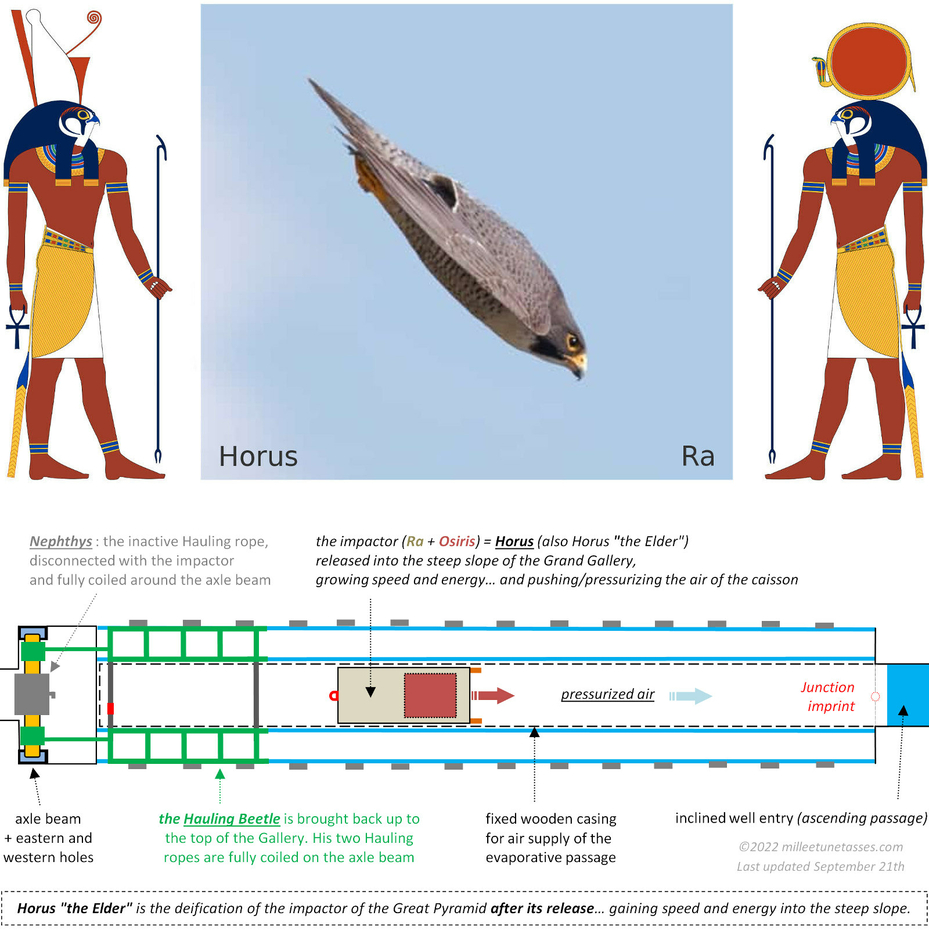
The impactor of the Great Pyramid of Egypt, gaining speed and energy into the steep slope of the Grand Gallery. Of course, the impactor is not really visible like shown on the draw: the impactor is hidden inside the fixed wooden caisson. Isis and Nephthys are both representations of the impactor's Hauling rope. Nephthys was only the deification of the rope, inactive and disconnected with the impactor when this one was securely in a locked position at the top of the Grand Gallery. At this very particular point of the operating cycle, the impactor has been glorified into Horus the child, waiting to grow into an adult because waiting to grow speed and energy after its release. Nephthys cannot be associated with another form of Horus.
24.07 Horus Contendings with Seth
The key point to understand who really was Horus and which part of the glorification process he was involved in, is to understand who, or what was he really endlessly fighting in the Osiris' myth describing his Contendings with Seth.
We've already seen this exact same idea of endless fights between two deities: it was Ra fighting the Great Serpent Apep in the Underworld, on his Solar barque. And we've seen that it was the glorifying representation of the endless sequential pressurization of the inclined well waters by the impactor of the Great Pyramid.
So, what is Horus all about, if it isn't about pressurization of water? Well, Seth is the answer, and we'll see that he is all about the air: Seth is the (pressurized) air pushed by the impactor inside the fixed caisson.
Another way of saying that is that Horus (the impactor unit) was fighting Seth (the pressurized air).
24.08 The boat of Horus made of wood but painted to resemble and act like a stone
The following excerpt is the key point to understand both Horus and Seth. Because their fight can't be about the waters of the well (that is represented into the Ra and Apep myth), it can only be about the air that is slowing down the fall of the impactor inside the fixed caisson: "Horus and Set challenged each other to a boat race, where they each raced in a boat made of stone. Horus and Set agreed, and the race started. But Horus had an edge: his boat was made of wood painted to resemble stone, rather than true stone."
The "boat made of wood" is the wooden cradle; and if Seth is all about the air, as we've already seen in the Seth's animal, it means that the boat made of wood but "painted to resemble to stone" is fighting the air: it is a wooden boat (a wooden cradle), but because it is painted to resemble stone, it also acts like a stone.
I had some trouble exactly figure this part out, because personally I would have described the design of the impactor: I would have say "it is a stone, painted to resemble wood". I didn't understand first that ancient Egyptians only focused here on the function. Most metaphors used to describe the operating of the Great Pyramid, are about the function, the role and not the design.
What ancient Egyptians did glorify is the fact that it was an impactor made of wood but acted ("painted") like it was made of stone.
"Throughout the day, Ra sailed across the sky in his barge and then descended down into the underworld at night […] Ra at this time becomes merged with Osiris, the judge of the dead, and Osiris is seen as the “corpse” and Ra as the “soul” of the single deity Ra-Osiris." https://www.worldhistory.org/Ra_(Egyptian_God)/
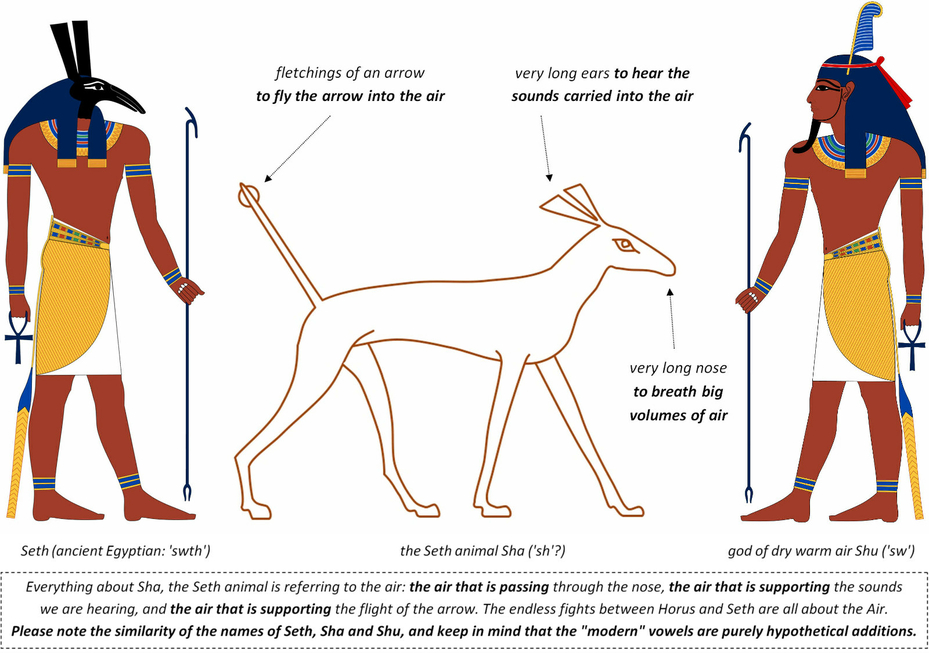
Seth and Shu draws by Jeff Dahl and the Seth animal Sha, after an original by E. A. Wallis Budgeat https://en.wikipedia.org/wiki/Set_(deity) and https://en.wikipedia.org/wiki/Shu_(Egyptian_god)
24.09 Seth and the Seth animal (Sha) are the deifications of some sort of air
"In art, Set is usually depicted as an enigmatic creature referred to by Egyptologists as the Set animal, a beast not identified with any known animal, although it could be seen as a resembling an aardvark, an African wild dog, a donkey, a hyena, a jackal, a pig, an antelope, a giraffe, an okapi, a saluki, or a fennec fox. The animal has a downward curving snout; long ears with squared-off ends; a thin, forked tail with sprouted fur tufts in an inverted arrow shape."
I really never thought I would be able to decipher Sha, the so enigmatic animal which represents Seth, but as soon as you think of the air, everything clarifies itself. If the Seth animal is depicted with gigantic nose and ears, as well as an inverted arrow shaped tail with fletchings, it is because of the air: the air that is passing through the nose, the air that is supporting the sounds, and the air that is supporting the flight of the arrow.
24.10 The names similarity between Seth, Sha and Shu
The Seth animal Sha, being the representation of the air, also explains the similarity of their names with the name of the god of dry and warm air Shu. More on Shu and Tefnut in Section 3
I also have to point out that egyptologists can't say the vowels when they are deciphering hieroglyphic texts. Seth, Sha and Shu looks already pretty similar, but their real original pronunciations were most probably even closer.
• Seth comes from the ancient Egyptian 'swth'. Seth on Wikipedia: /sɛt/; Egyptological: Sutekh - swtẖ ~ stẖ
• Sha, the Seth Animal: I've found no reference on his Egyptian name. I'm only questioning if it wouldn't be something like 'sh'.
• Shu comes from the ancient Egyptian 'sw'. Shu on Wikipedia: Shu (Egyptian šw)
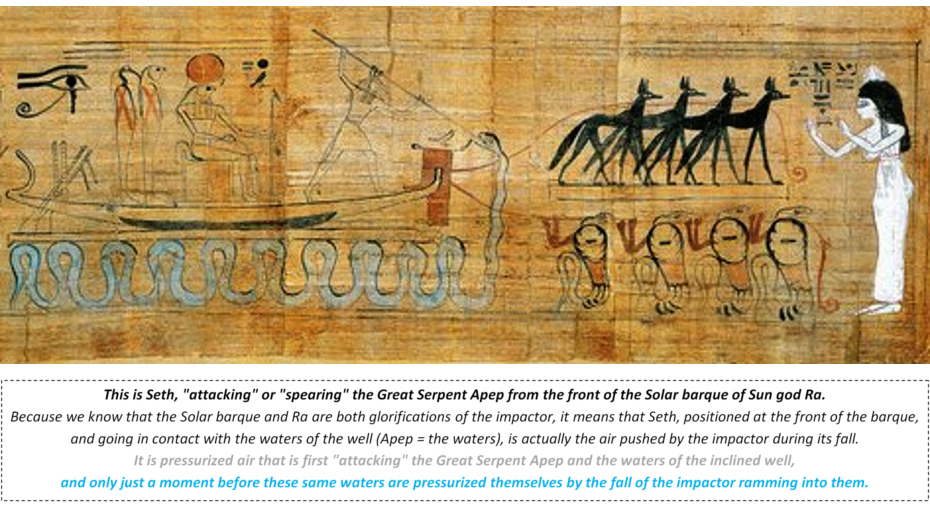
Seth, "attacking" or "spearing" the Great Serpent Apep from the front of the Solar barque of Sun god Ra.
24.11 The inclined well is first hit by pressurized air: Seth, at the front of the impactor's Solar barque
On the above image, this is Seth, "attacking" or "spearing" the Great Serpent Apep from the front of the Solar barque of Sun god Ra. Because we know that the Solar barque and Ra are both glorifications of the impactor, it means that Seth, positioned at the front of the barque, and going in contact with the waters of the well (Apep = the waters), is actually representing the air that is pushed by the impactor during its fall.
It is pressurized air that is first "attacking" the Great Serpent Apep and the waters of the inclined well, and only just a moment before these same waters are pressurized themselves by the fall of the impactor ramming into them.
There are 2 sequences of pressurization occurring in the inclined well, and there are 2 pressurizes waves getting out of it towards the fog nozzle: first the pressurized air that allows a much more efficient evaporative process in the horizontal passage (more air in the same volume, means you can force more water in that volume: hence, you create more cold), and second the pressurized water transformed into microdroplets that are evaporating in pressurized air.
24.12 The great spear of Seth piercing Apep is about the Junction imprint "piercing" the well
We've already seen that Apep is a representation of the pressurized waters of the well due to the ramming of the impactor; but in the following excerpt, we have the description of the impact itself, with "the boat of Ra" (i.e. the wooden cradle) trapped in Apep's massive coils".
The ejection of the pressurized water is referred to as flooding waters, but more importantly there is also Seth "piercing the side of Apep with a great spear". In my opinion, this piercing is about the Junction imprint: the little hole without which nothing could have ever gotten out of the inclined well.
"According to one myth, Apep would hypnotise the sun god and all of his followers, except Set who would repel the serpent by piercing his side with a great spear. In some texts, Apep would trap the boat of Ra in his massive coils (referred to as sandbanks) or cause the waters of the underworld to flood to overwhelm him." https://ancientegyptonline.co.uk/apep/
24.13 The pressurized air forced into the well is causing intense rumbling into the entire structure
Most certainly, the reference to Apep causing the Underworld to "rumble" during his fights with Sun god Ra (the wooden part of the impactor), is referring to the pressurized air of the fixed caisson, forced into the well before getting out of it through the Junction imprint. It would have looked and sound like boiling water.
"It was thought that his (Apep, also Apophis) terrifying roar would cause the underworld to rumble." https://en.wikipedia.org/wiki/Apep
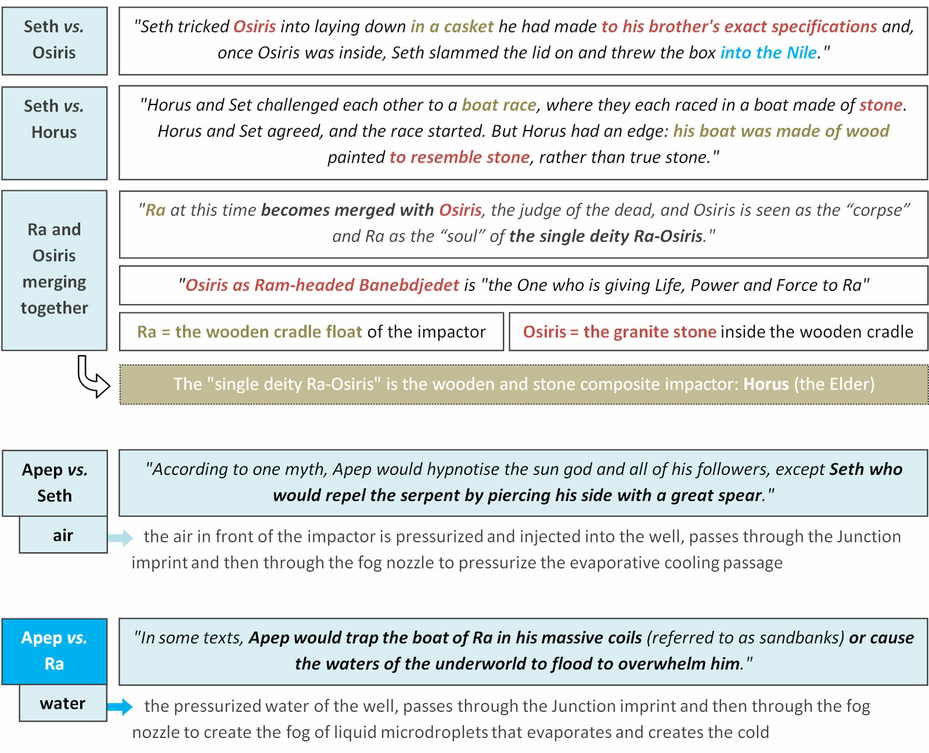
Ancient Egyptian myth excerpts involving Horus, Ra, Seth, Osiris and Apep.
24.14 Not only Seth is all about Air, he is also a key metaphor regarding the operating of the impactor and the inclined well
The Osiris myth, one of the most popular myth in ancient Egypt, is the most important of all, because it is revealing it is Seth who was responsible for Osiris to lay down in a casket that fits his body perfectly, and for throwing Osiris into the Nile.
Of course, it is only a metaphor: what it really means is that Seth is some way involved in the operating of the "Osiris casket". In other words, Seth is directly referring to the operating of the impactor of the Great Pyramid, and the fact that at some point, it was simply thrown into water coming from the Nile.
"The story of Horus comes out of the Osiris Myth which was one of the most popular in ancient Egypt and gave rise to the Cult of Isis. This story begins shortly after the creation of the world when Osiris and Isis ruled over a paradise they created. When men and women were born from the tears of Atum (Ra) they were uncivilized and barbaric. Osiris taught them culture, religious observances to honor the gods, and the art of agriculture. The people were all equal at this time, men and women, owing to the gifts of Isis which were dispensed to all. Food was plentiful and there was no want or need unfulfilled.
Osiris' brother, Set, grew jealous of him and this envy turned to hatred when Set discovered that his wife, Nephthys, had transformed herself into the likeness of Isis and seduced Osiris. Set was not angry with Nephthys, however, but focused his revenge on his brother, "The Beautiful One", who had presented a temptation too strong for Nepthys to resist. Set tricked Osiris into laying down in a casket he had made to his brother's exact specifications and, once Osiris was inside, Set slammed the lid on and threw the box into the Nile.
The casket floated down the river to eventually lodge in a tamarisk tree by the shores of Byblos where the king and queen admired its beauty and sweet scent and had it cut down for a pillar in their court." https://www.worldhistory.org/Horus/
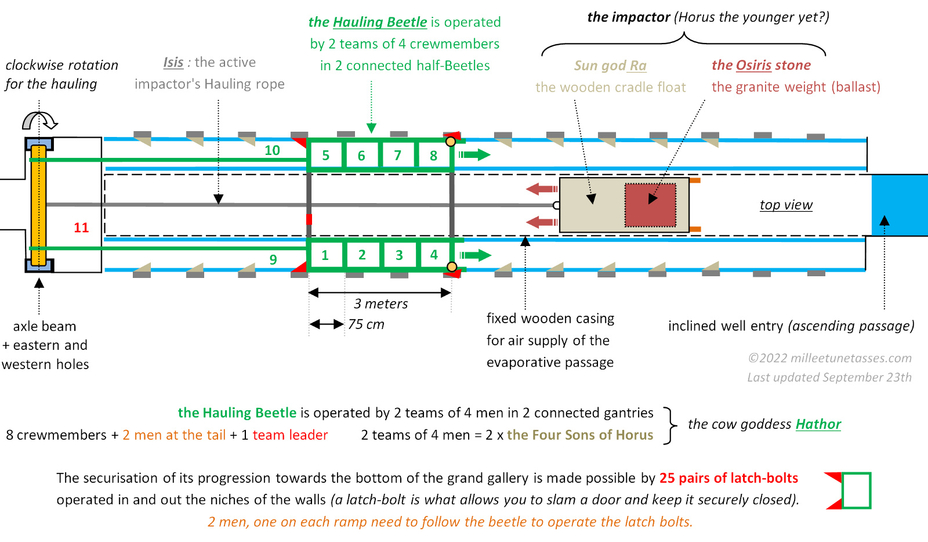
24.15 The impactor of the Great Pyramid of Egypt, being hauled up by the Hauling beetle to the top of the Grand Gallery
Top view (adapted) of the impactor of the Great Pyramid of Egypt, being hauled up by the Hauling beetle, to the top of the Grand Gallery. Of course, the impactor is not really visible like shown on the draw: the impactor is hidden inside the fixed wooden caisson.
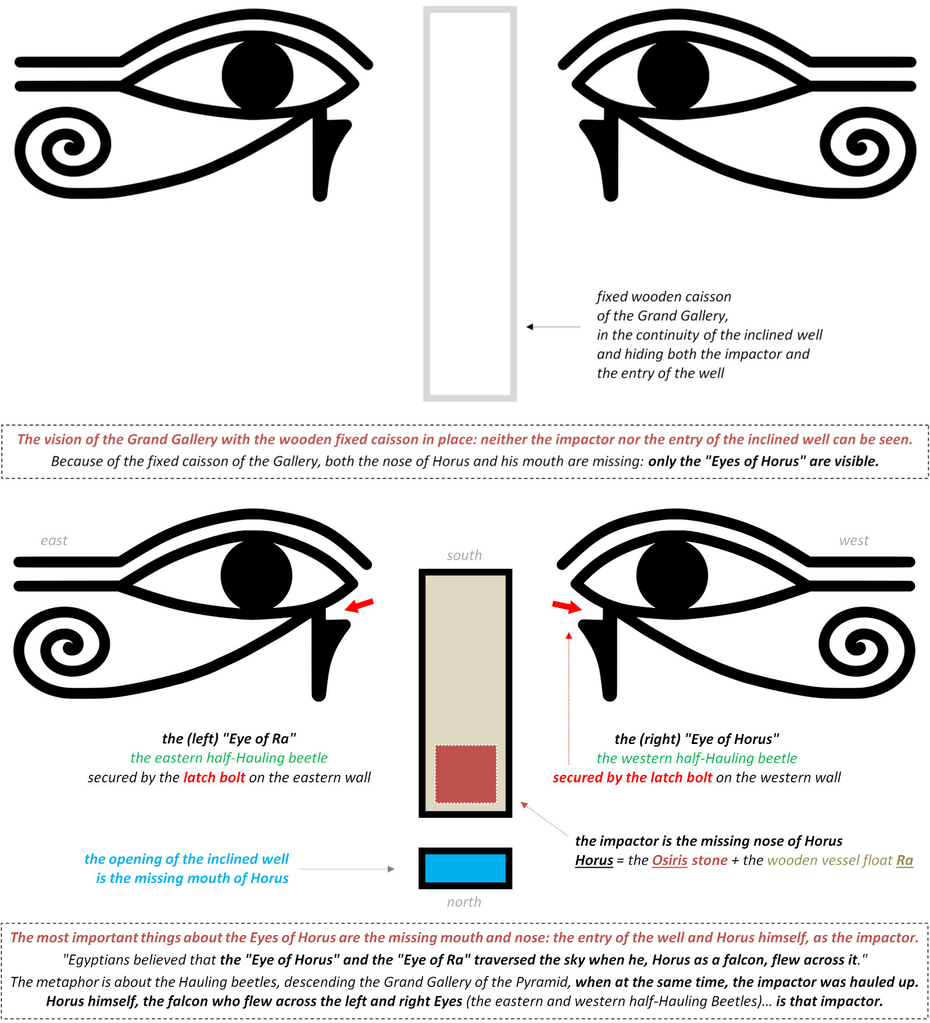
The representations of the Eye of Horus and the Eye of Ra: https://commons.wikimedia.org/wiki/File:Eye_of_Ra.svg
24.16 The fixed caisson of the Grand Gallery is the one hiding the missing parts of Horus' face: only the Eyes are visible
The "Eye of Horus" is known by everybody, but there are actually two eyes mentioned: there is the left eye and the right eye. Nothing fancy, just regular eyes. The problem is that what we know for sure about ancient Egyptians is that they were very thorough with the way they were building things or creating masterpieces of art.
So, if they were drawing eyes everywhere, and only the eyes of the face, it is only because the other parts of the face are hidden. What I mean is that just like the hidden meaning of the hieroglyphic signs, or the real hidden meaning behind their obsession for the Heart (a metaphor of the functioning of the inclined well), the representations of the Eyes of Horus are incomplete: you need the key to "see" the entire picture; and the key in that matter is the fixed wooden caisson of the Grand Gallery.
Because of the caisson which is imperative to use the air moved by the fall of the impactor, both the impactor and the opening of the inclined well were hidden.
And because we are talking about the Eyes of Horus, the missing parts of the face are about Horus' face.
The hidden impactor, in the middle of the face is Horus himself.
"Egyptians believed that the "Eye of Horus" and the "Eye of Ra" traversed the sky when he, Horus as a falcon, flew across it." https://en.wikipedia.org/wiki/Horus
Here, the metaphor is about the Hauling beetles, descending the Grand Gallery of the Pyramid, when at the same time, the impactor was hauled up; and most of all, it is about the fall of the impactor itself, Horus who like a falcon, flew across the left and right Eyes (the eastern and western half-Hauling Beetles).
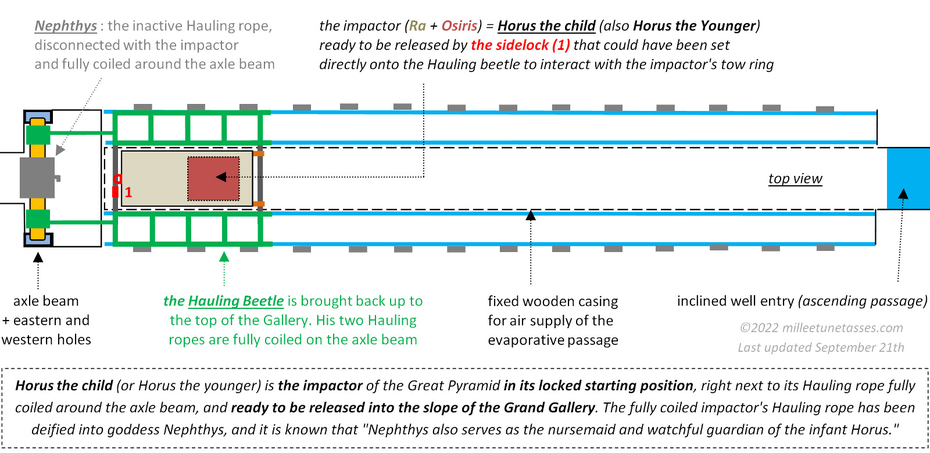
The impactor of the Great Pyramid, ready to be released into the slope of the Grand Gallery. Of course, the impactor is not really visible like shown on the draw: the impactor is hidden inside the fixed wooden caisson. More on Isis (the active impactor's Hauling rope) and Nephthys (the inactive and disconnected impactor's Hauling rope), in previous Section 23
24.17 Nephthys also serves as the nursemaid and watchful guardian of Horus the child (Horus the younger)
I was wondering why ancient Egyptians had to create Nephthys, the deification of the Hauling rope of the impactor, completely coiled around the axle beam, and disconnected with the impactor, and Horus the child is maybe the answer. Because when the impactor was in its starting locked position at the top of the Gallery, it was Nephthys who was just next to him; hence the following excerpt: "It is Nephthys who assists Isis in gathering and mourning the dismembered portions of the body of Osiris after his murder by the envious Set. Nephthys also serves as the nursemaid and watchful guardian of the infant Horus." https://en.wikipedia.org/wiki/Nephthys
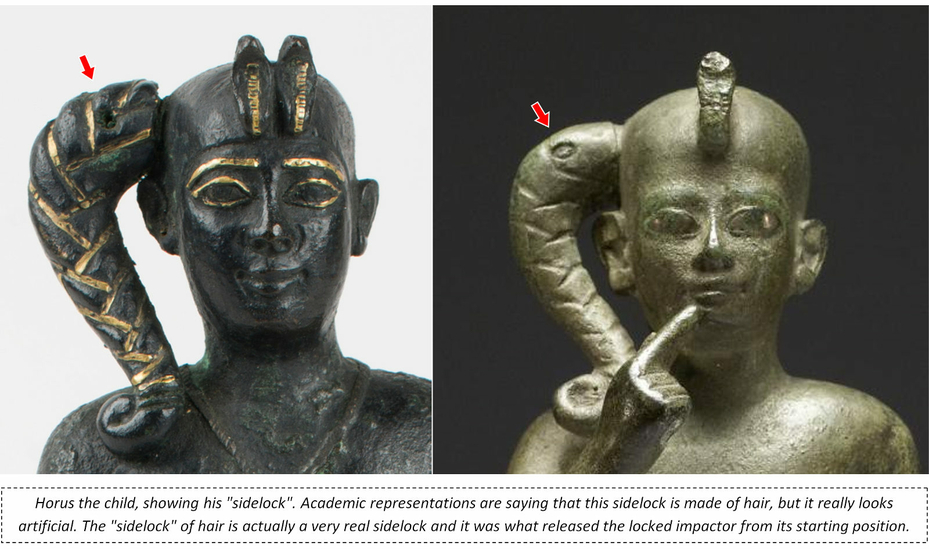
Figure of Horus the child at the Saint Louis Art Museum: https://www.slam.org/collection/objects/27044/
and at the Walters Art Museum: https://art.thewalters.org/detail/22710/horus-the-child-4/
24.18 The sidelock of Horus is a real sidelock mechanism made for the release of the impactor
Egyptologists called "sidelock" what is represented on the head of Horus the child, because of its resemblance with the sidelock mechanism used in firearms. The thing is that this time, they were right: it really is the representation of the mechanism that triggered the release of the impactor. Horus the child is the impactor, locked on top of the Gallery, waiting to grow speed and energy.
If you look closely to the above figure of Horus the child, you'll see that their interpretation of the sidelock, as being hair, isn't very satisfying: the "hair" sidelock really doesn't look like it is coming from the real hair of Horus, which is hidden under his head covering. There is also a strange circular area onto the sidelocks (red arrows) that are almost present on every single figure I've been looking at; maybe it is kind of a button of some sort.
I was wondering where the mechanism that was triggered to release the impactor would have been set on the top platform of the gallery; but looking at the draw I've made, I'm wondering if the sidelock couldn't have been positioned right onto the Hauling beetle itself.
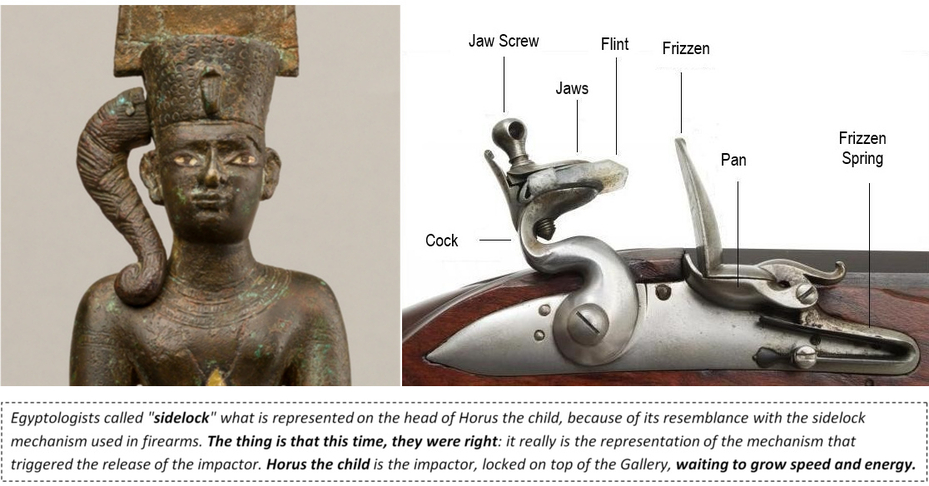
Figure of Horus the child, at the Metropolitan Museum of Art, New-York: https://www.metmuseum.org/art/collection/search/570699
A flintlock mechanism, (French lock design), very similar to a sidelock, by Engineer comp geek: https://simple.wikipedia.org/wiki/Flintlock
24.19 Horus the child is the impactor in its locked position at the top of the Gallery, waiting to be released and grow speed and energy
We've seen that Horus was the deification of the impactor unit, but the explanation of Horus the child is another piece of work: Horus the child is about the initial position of the impactor, just before its release.
The whole point of the impactor is to gain speed and energy in the slope of the Grand Gallery, but if you want to represent it in its starting position, before the release, you can't use Horus as we know it, because he is all about speed and energy. There is no Horus yet, but you can use another metaphor: Horus as child, because in this child is present all his future energy, just waiting to be released. Horus the child is about the energy potentially residing in himself.
Horus the child is the impactor, locked in its starting position and ready to be released.
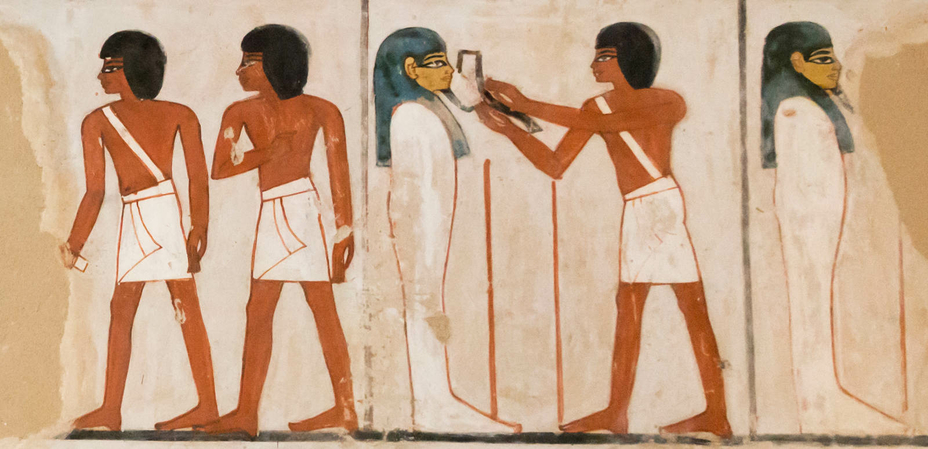
The Tomb of Menna, Theban Tomb TT69 in Sheikh Abd el-Qurna, part of the Theban Necropolis on the west bank of the Nile, Luxor. Menna was Scribe of the Fields of the Lord of the Two Lands in the 18th dynasty. Photographed by kairoinfo4u: https://www.flickr.com/photos/manna4u/14001055450/in/photostream/
24.20 The opening of the mouth is about the mechanism which triggered the release of the impactor
When I started to look attentively at the sidelock on Horus' head, I first thought "weird, it looks like a fish is stuck on his head"; and the little " button" which appears on the upper part of the sidelock kind of looks like an eye, the eye of the fish. Then I let it go for a while, but I started to realize that if Horus the child was pointing his mouth with a finger, what if this was related to the "opening of the mouth"?
Horus' mouth is closed, and he's pointing to it like he was saying "see, my mouth is closed, completely close, I'm a good kid". But we also know what he is also representing: the impactor locked in its starting position before its release.
It should mean that all of the above is connected: the sidelock, the mouth, the impactor's locked position, and the opening of the mouth.
I think the opening of the mouth is describing the release of the impactor. Probably the sidelock end had a small weight that triggered the opening of some kind of jaw: the opening of the mouth. In the above image of the tomb of Menna, the Peseshkaf does look like it is forming a jaw with the "beard" .
24.21 The opening of the mouth actually is really supposed to "split, divide or separate" (two) things from each others
What is really interesting is that just after this thought, I saw the following excerpt about the opening of the mouth, where it clearly states that this ritual is about separating things, and not really opening the mouth of anybody; it is even mentioning separating two things from each others: " Translating literally as "opening of the mouth," the Egyptian terms for the ritual are wpt-r and um-r. According to Ann Macy Roth, the verb wpi connotes an opening that splits, divides or separates: "it can be used, for example, to describe the separation of two combatants, the dividing of time, or even an analysis or determination of the truth."
https://en.wikipedia.org/wiki/Opening_of_the_mouth_ceremony
24.22 The "awaken" reference to mimick the "inactive" impactor, waiting to be released
"During the funeral, the procession would make its way to the tomb. At the entrance to the tomb the Sem Priest would fall into a trance, and then be symbolically woken by the other priests. The sem Priest would announce; “I have seen my father in all his forms” and the other priests would respond by calling on the Sem Priest to take the place of Horus and protect his father Osiris (the deceased). […] At this point the statues of the deceased would also be awoken so that they could receive offerings for the deceased. Then the lector priest would bring the foreleg of the sacrificed calf (which was similar in shape to the adze used in the ritual) to the mummy." https://ancientegyptonline.co.uk/openingofthemouth/
24.23 The Peseshkaf is shaped like the tail of a fish
And back to our fish, about the instrument used for the opening of the mouth: "Peseshkaf is an instrument used for this ritual, psš (“an instrument for Opening of the mouth”) + k?f (“obsidian”). This instrument was made of stone and shaped like the tail of a fish." https://en.wikipedia.org/wiki/Opening_of_the_mouth_ceremony
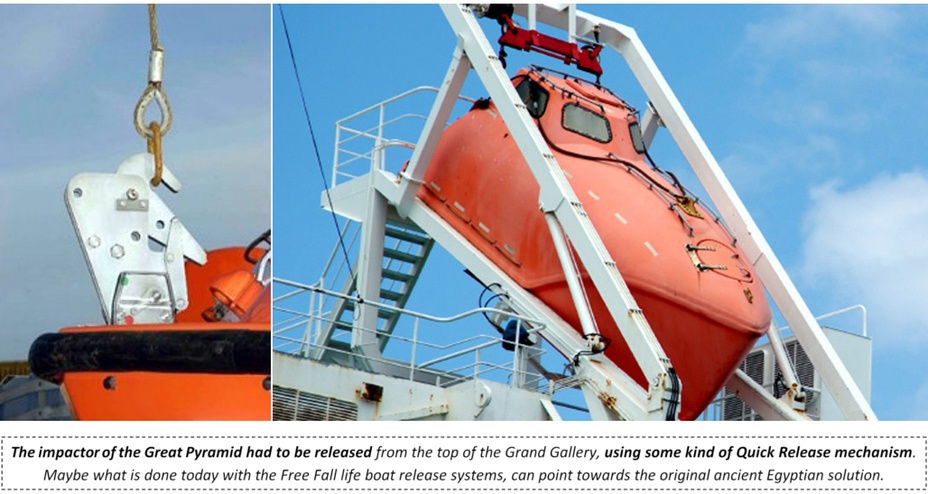
On load mechanism: http://ajishnavigator.blogspot.com/2011/06/on-load-off-load-release-mechanism-of.html
Free Fall lifeboat release: https://www.marineinsight.com/maritime-law/types-of-lifeboat-release-mechanisms-solas-requirements-for-lifeboats/
24.24 The Quick Release system of the impactor vs. the Free Fall life boat release
The impactor of the Great Pyramid had to be released from the top of the Grand Gallery, using some kind of Quick Release mechanism. Maybe what is done today with the Free Fall life boat release systems, can point towards the original ancient Egyptian solution.
I'm thinking that part of the mechanism was set onto the Hauling beetle, while the other part was set onto the impactor itself. Most probably the impactor already had a ring, so that it could have been hauled out of the well with a crook before the Isis Hauling rope could have been connected with it, and start the hauling process.
It would mean that the part that was set onto the Hauling beetle would have been a second crook, and this is this crook that would have been needed to unhook with the ring of the impactor for its release.
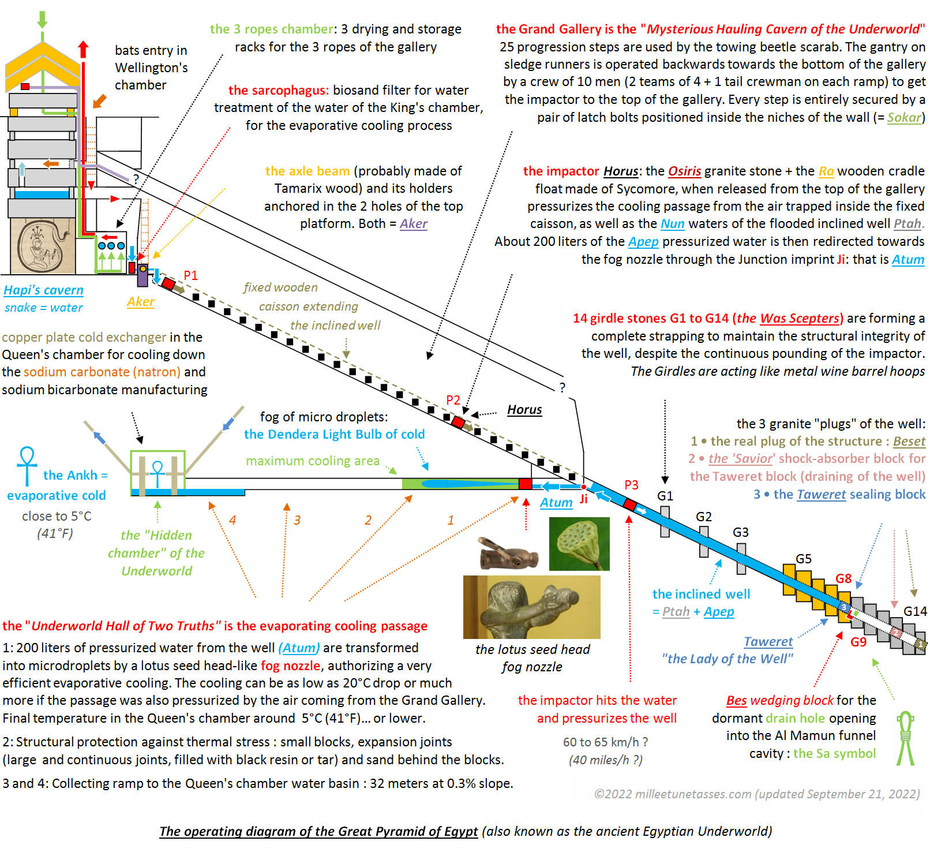
24.25 The Great Pyramid of Egypt in operation for evaporative cold production
The operating diagram of the Great Pyramid of Egypt. Last updated 2022, September 21.
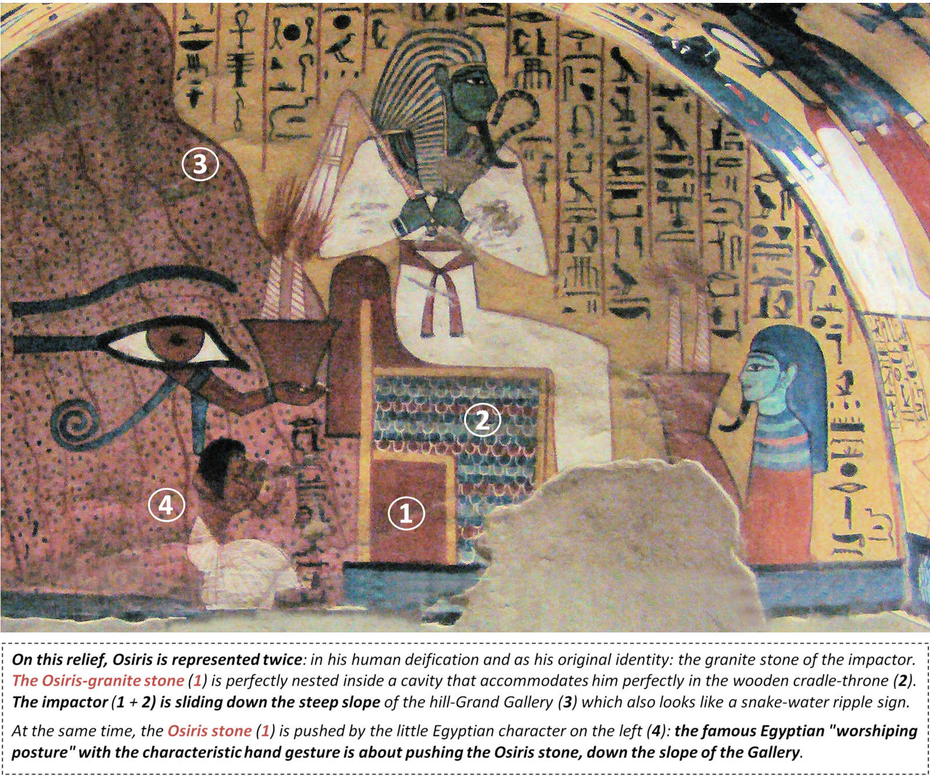
The Egyptian "worshiping posture" with the characteristic hand gesture is about pushing the Osiris stone, down the slope of the Gallery.
24.26 The characteristic Egyptian "worshiping" posture is about pushing and putting the Osiris stone in motion
What is incredible about the relief in the tomb of Paschedu, at Deir el-Medina, is that it allows us to understand this so particular gesture that ancient Egyptians are showing in their characteristic worshiping posture: if they have their hands just like we would do if we want to push something, it is because they really are pushing something themselves!
Here it is shown that they are pushing the Osiris stone.
We've seen that it is this stone which has been deified into Osiris, and because we also know that "Osiris as Ram-headed Banebdjedet is "the One who is giving Life, Power and Force to Ra", we can assume that the "pushing the Osiris stone" gesture is an attempt to "participate" in some ways into the travel of Ra in his Solar barque; an attempt to keep the impactor moving and creating the evaporative cold.
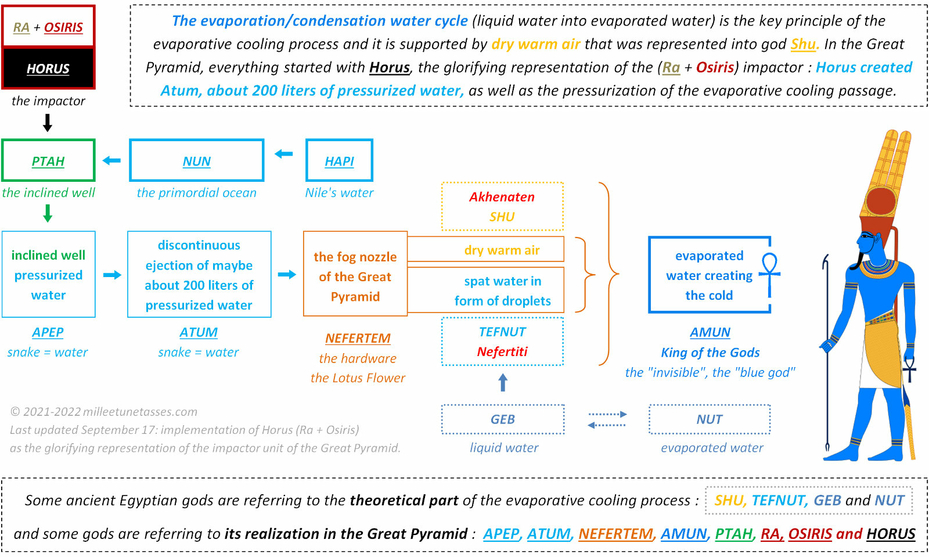
24.27 Diagram of the gods involved into the operating of the Great Pyramid of Egypt for evaporative cold production
Each and every one of these gods are deifications of either theoretical knowledge or experimental achievements that occurred in the Great Pyramid.
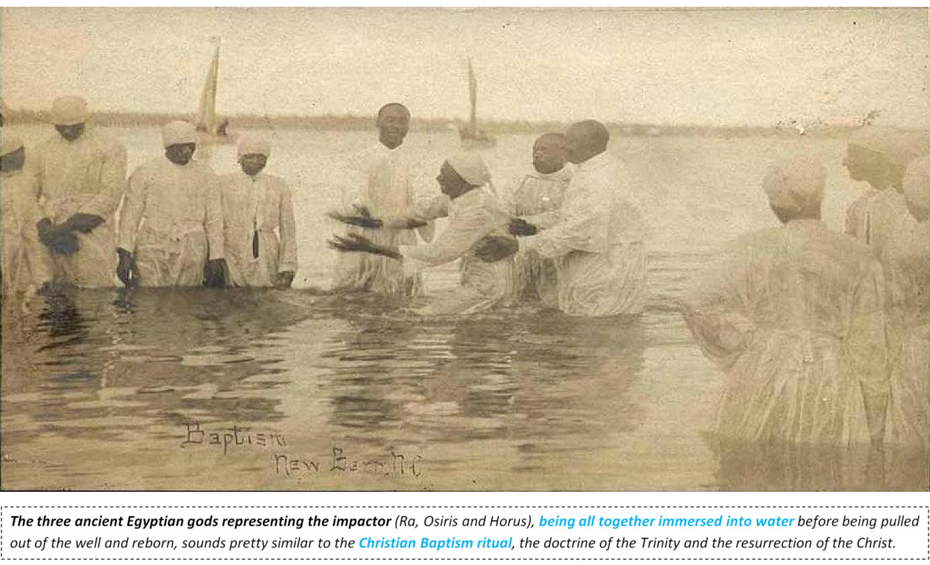
A river baptism in North Carolina at the turn of the 20th century. Full-immersion (submersion) baptism continues to be a common practice in many African-American Christian congregations today. https://en.wikipedia.org/wiki/Baptism#/media/File:River_baptism_in_New_Bern.jpg
24.28 It is possible that [Ra, Osiris and Horus] are the origin of the Christian Trinity and Baptism into water
I'm sure many will find very close similarities between what was realized inside the Grand Gallery, and some religious beliefs, like resurrection of the Christ and the Baptism ritual.
Because, one way of summarizing what we know of the operating of the impactor of the Great Pyramid, in just a few words, is that the three gods who were the glorification of the impactor: Ra, Osiris and Horus, were all together, the three of them constantly immersed into the waters of the well; and every time they would rise again from these waters and reborn again, until the next cycle begins.
These three ancient Egyptian gods, immersing themselves before being reborn, sounds very similar with the Christian Baptism ritual and the doctrine of the Trinity: "the three consubstantial gods".
"Baptism […] is a form of ritual purification—a characteristic of many religions throughout time and geography. In Christianity, it is a Christian sacrament of admission and adoption, almost invariably with the use of water. It may be performed by sprinkling or pouring water on the head, or by immersing in water either partially or completely, traditionally three times, once for each person of the Trinity." https://en.wikipedia.org/wiki/Baptism
"The Christian doctrine of the Trinity […] defines one God existing in three coequal, coeternal, consubstantial divine persons…" https://en.wikipedia.org/wiki/Trinity

Femmes en Haïk and Haïk porté par des femmes à Alger by Mus52: https://fr.wikipedia.org/wiki/Ha%C3%AFk_(v%C3%AAtement)
24.29 It is possible that the Haïk is originating in the Eyes of Horus (highly hypothetical)
Finally, this idea of hiding completely one's face and showing only the eyes, is reminding me of the Haïk, the traditional women's garment that is worn in the Maghreb region and that only let the eyes of the women visible.
Is it possible that the Eyes of Horus would be the origin of the Haïk? If it is, it would mean that the Haïk would be originating in the attempt to reproduce the missing parts of Horus' face, so that only the eyes are visible.
24.30 Summary of the study: hidden behind the academic vision of the ancient Egyptian religion, a vast number of metaphors are describing some of the most advanced science and technological knowledge of that time : ancient Egyptian gods were nothing else than pharaohs' metaphoric self-glorifications of their theoretical and experimental scientific accomplishments in physics and chemistry.
Pharaohs used the power of Science to legitimate themselves as kings of Egypt : they forged an entire religion, based on science to rule their kingdom, and they presented that science as Magic.
The end game of this technological program that probably started on the very first Dynasty, was the Great Pyramid of Giza where evaporative cooling was engineered in the known part of the pyramid from the pressurized water produced in the inclined well, known today as the ascending passage.
The evaporative cold simply took advantage of the power of water, and was most probably necessary to cool down chemical manufacturing of sodium carbonate and sodium bicarbonate produced by an ammonia-soda Solvay process, as suggested by the very strong ammonia smell and the limestone kiln in the so-called burial chamber of the Red Pyramid. At that time, sodium carbonate was called natron, and it was the salt used for the mummification of the pharaohs (Sections 14, 15 and 16).
The cooling seems to have represented the most difficult part of the process, as suggested by the Step Pyramid's official name : according to scholars, the very first pyramid complex, the Step Pyramid of Djoser, was called "the refreshment of the Gods". No doubt that a more accurate translation would certainly be "the cooling of the Gods".
It means that ancient Egyptians were the first civilization to master a Solvay-like process for sodium carbonate manufacturing, long before it got reinvented in the 1800's in Europe. The key elements of that process is the temperature control of the chemical reactions (the cooling), and the dome shaped plate necessary for the counterflow chemical reactions to occur in an efficient way. That counterflow reaction plate is what really is the disc of Sabu.
As shown with Akhenaten and Nefertiti, the creation of the evaporative cold was the most sacred accomplishment of all (Section 17), and this is exactly what the Dendera Light is all about : the Dendera Light is the fog of microdroplets of liquid water that evaporates and creates the cold. Talking about the snake inside the Dendera Light Bulb : "The field surrounding Ra’s snake form is referred to in ancient Egyptian literature as protective magical energy in liquid form that all gods and pharaohs possess" (Faulkner, Section 2).
Everything that had been done in the Great Pyramid of Giza inspired most of the ancient Egyptian religion, and it had been glorified into what we know today as the Underworld.
The Underworld is referring to the chambers and passages of the Great Pyramid of Khufu, and in particular to the Grand Gallery where a hauling gantry beetle operated a wooden coffin shaped impactor that had a small nested granite block inside it. The impactor generated endlessly, over and over, maybe every 15 minutes the pressurized water that was then transformed into a fog of microdroplets inside the horizontal cooling passage.
The Grand Gallery of the Great Pyramid where the act of hauling was done, is the "Secret Hauling Cavern of the Underworld" described in the Amduat "Book of the Hidden Chamber".
The most important chamber of the Great Pyramid wasn't the King's chamber that only was the main water tank of the pyramid, but the Queen's chamber, the only one on the central axis of the pyramid. Because the Queen's chamber was inaccessible from the rest of the pyramid, it was glorified into the "Hidden Chamber of the Underworld" (Section 11), and because the Queen's chamber was the coolest place in the pyramid (about 5°C / 41°F), and with a constant 100% Humidity rate, this chamber was the one where the biggest amount of very hard salt encrustation had been documented by the first explorers of the pyramid in the 1800's and before it had been removed in 1998 by Zahi Hawass (Section 1). Very hard salt encrustation is the signature of the evaporative cooling process, even nowadays.
The most incredible thing is that pretty much everything I've just said, actually appears in many myths, and they don't even originate from ancient Egypt : the "Churning of the Ocean" Hindu myth that produces the immortal nectar Amrita, the Tibetan Prayer Wheels operated to give small amounts of 'merit' to too lazy Naga snakes, and the entire Norse mythology with Thor's magical hammer endlessly fighting another Great Serpent of the Underworld and producing a mist of cold from a mysterious well that would be opposed to hellishly hot heat waves.
I'm talking a lot about the impactor of the Great Pyramid, but it is nothing compared to the tremendous impact caused by what the ancient Egyptians had accomplished within the 78 years of the Great Pyramids Era, from Djoser to the Great Pyramid: the entire ancient World had been shaken up in their deepest beliefs beyond all comprehension; and we are still talking about it today.
Poster un commentaire

